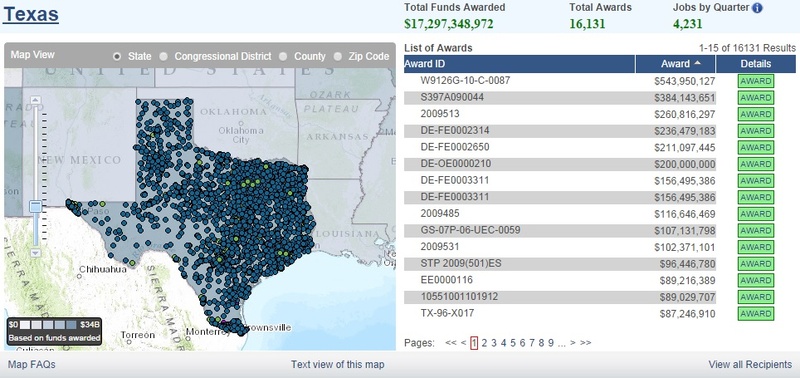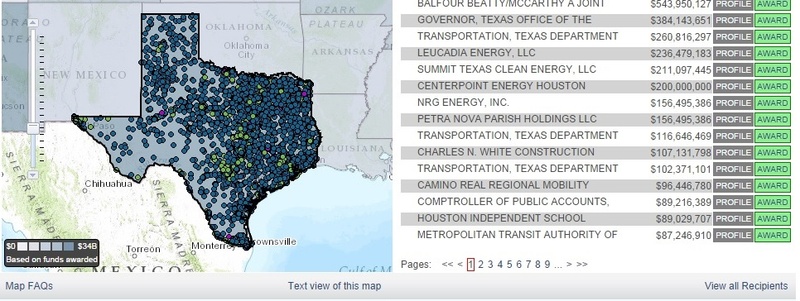Recovery.gov, now less useful!
Last month, news broke that Recovery.gov would be losing a significant chunk of useful data and functionality after its contract with the proprietary service the government uses to track entities it does business with expired at the end of September. Access to these identifiers (DUNS numbers) costs the government millions of dollars every year.
Yesterday, entity data was disconnected from Recovery.gov. The move’s impact was immediately clear.
Entity information served as the beating heart of Recovery.gov. Without it, the site’s data just doesn’t flow like it should. The screenshot below, taken on Oct. 1, shows the website’s visualization tool without recipient information.

Compare this to an otherwise identical screenshot taken on Sept. 26th, which shows the visualization tool with recipient information. Before the license expired, you could tell at a glance who the top Texas recipients were, get a sense of how much money was funneled to the State government before being spent and more.

Now that sort of analysis is improbable, if not impossible.
When this move was first made public, Sunlight argued that “without this license, Recovery.gov will no longer be able to display data about the entities that ultimately received recovery money. The interactive map and advanced searching that helped make Recovery.gov’s name will lose much of their luster and the websites’ ultimate disappearance will likely be hastened.”
It is clear that prediction was correct. You can no longer tell who was pulling in hundreds of millions of dollars of recovery funds. You can no longer tell how much was going to state agencies or private companies. This underscores the argument that the government should move beyond the proprietary DUNS system towards more open identifiers that can’t be ripped away and doesn’t cost taxpayers millions of dollars. Recovery.gov was set up as a transparency tool — without robust recipient information it is anything but.
Sunlight has highlighted this multiple times over the past couple of weeks, first at the Treasury Department’s Data Transparency Town Hall and again at Data Transparency 2014. It is clear that this data must be freely available without license restrictions to ensure that Federal spending is as transparent and accountable as Congress intended it to be.
When Recovery.gov announced the inevitable disappearance of recipient data it was unclear what exactly would be going away, but we were particularly concerned that the “cumulative national download file” would be removed. Losing functionality on a nifty visualization tool is bad enough, but losing access to vital historical data is completely unacceptable.
With that in mind, we moved to download all of the bulk data that we could find before the deadline. We’re still trying to figure out what to do with all of this data, which parts are going to disappear from Recovery.gov forever and which will stick around, and if we’re even legally allowed to share it publicly now that we’ve downloaded it.
That last part is perhaps the best illustration of the problem with relying on a proprietary entity tracking system. This is information downloaded from a government website about the recipients of taxpayer money, but it may be illegal to share.

